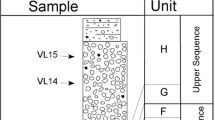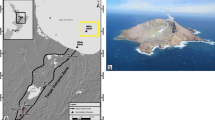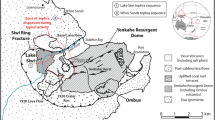Abstract
The Rainier Mesa ash-flow is a large (1200 km3), 11.6 My old, chemically zoned unit that ranges in composition from 55 to 76% SiO2 — one of the largest chemical ranges ever observed in a large volume ash-flow sheet. Two chemical trends occur in this sheet, a low silica (55–66% SiO2) and a high silica (>66% SiO2) trend. Ninety per cent of the Rainier Mesa sheet occurs in the high silica trend. Immediately beneath the Rainier Mesa sheet is a thick tephra sequence. The chemical variation of this sequence is nearly equivalent to the high silica portion of the Rainier Mesa ash-flow sheet (about 66–78% SiO2). Throughout the tephra sequence numerous small ash-flow layers occur, and each ash-flow layer is chemically zoned from more evolved at the base to less evolved at the top. This is consistent with having been erupted from a zoned magma body. The lowest silica tephra units are at the base of the sequence and the highest silica units are at the top — that is, the large-scale chemical trend of the entire sequence is opposite to that of the individual ash-flow layers. These ash-flow layers are of very small volume. The tephra sequence provides a unique record of the incremental development of the zoned, high silica portion of the Rainier Mesa magma body.
Similar content being viewed by others
References
Baker BH, McBirney AR (1985) Liquid fractionation, III, geochemistry of zoned magmas and the compositional effects of liquid fractionation. J Volcanol Geotherm Res 24:55–81
Blake S, Fink JH (1987) The dynamics of magma withdrawal from a density stratified dike. Earth Planet Sci Lett 85:516–524
Blake S, Ivey GN (1986) Magma mixing and the dynamics of withdrawal from stratified reservoirs. J Volcanol Geotherm Res 30:201–230
Broxton DE, Warren RG, Byers FM Jr, Scott RB (1989) Chemical and mineralogic trends within the Timber Mountain-Oasis Valley caldera complex, Nevada: evidence for multiple cycles of chemical evolution in a long-lived silicic magma system. J Geophys Res 94:5943–5960
Byers FM Jr, Carr WJ, Orkild PP, Quinlivan WD, Sargent KA (1976) Volcanic suites and related cauldrons of Timber Mountain-Oasis Valley caldera complex southern Nevada. US Geol Surv Prof Pap 919:1–70
Cas RAF, Wright JV (1987) Volcanic Successions Modern and Ancient. Allen and Unwin, London, 528 pp
Farmer GL, Broxton DE, Warren RG, Pickthorn W (1991) Nd, Sr, and O isotopic variations in metaluminous ash-flow tuffs and related volcanic rocks at the Timber Mountain/Oasis Valley Caldera Complex, SW Nevada: implications for the origin and evolution of large-volume silicic magma bodies. Contrib Mineral Petrol 109:53–68
Hildreth W (1981) Gradients in silicic magma chambers: implications for lithospheric magmatism. J Geophys Res 86:10153–10192
Lipman PW, Christiansen RL, O'Connor JJ (1966) A compositionally zoned ash-flow sheet in southern Nevada. US Geol Surv Prof Pap 524-f:1–47
Mahood GA (1981) A summary of the geology and petrology of the Sierra La Primavera, Jalisco, Mexico. J Geophys Res 86:10137–10152
Mills JG Jr (1991) The Timber Mountain Tuff, Southwestern Nevada Volcanic Field: geochemistry, mineralogy and petrogenesis. PhD Thesis. Michigan State Univ, East Lansing Michigan, 332 pp
Schuraytz BC, Vogel TA, Younker LW (1989) The Topopah Spring Tuff: evidence for dynamic withdrawal from a layered magma body. J Geophys Res 94:5925–5942
Smith RL (1979) Ash-flow magmatism. Geol Soc Am Spec Pap 180:5–27
Spera FJ, Yuen DA, Greer JC, Sewell G (1986) Dynamics of magma withdrawal from stratified magma chambers. Geology 14:723–726
Valentine GA, Wohletz KH (1991) Sources of unsteady column dynamics in pyroclastic flow eruptions. J Geophys Res 96:21887–21892
Warren RG, Valentine GA (1990) Precursor eruptive activity of the large-volume Rainier Mesa Tuff, southwestern Nevada, U.S.A. [abstr]. New Mexico Bur Mines Miner Resour Bull 131:287
Author information
Authors and Affiliations
Rights and permissions
About this article
Cite this article
Huysken, K.T., Vogel, T.A. & Layer, P.W. Incremental growth of a large volume, chemically zoned magma body: a study of the tephra sequence beneath the Rainier Mesa ash flow sheet of the Timber Mountain Tuff. Bull Volcanol 56, 377–385 (1994). https://doi.org/10.1007/BF00326463
Received:
Accepted:
Issue Date:
DOI: https://doi.org/10.1007/BF00326463




